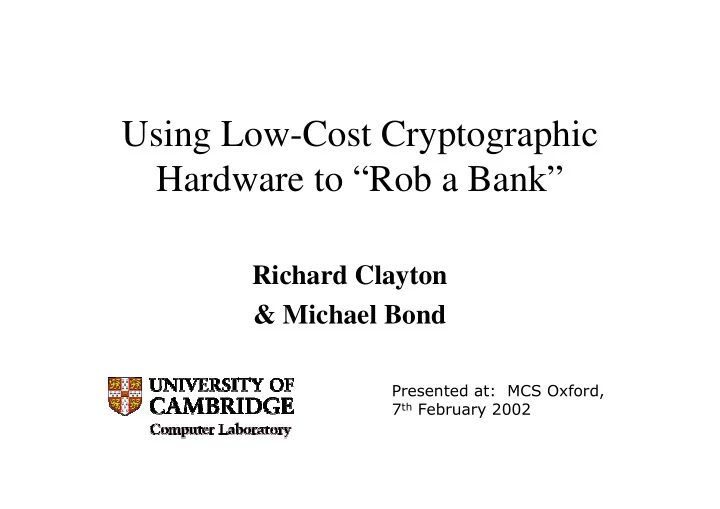

Using�Low-Cost�Cryptographic� Hardware�to�“Rob�a�Bank” Richard�Clayton &�Michael�Bond ��������������������������� � �� �������������
Summary • Keys�and�Ciphers • The�IBM�4758�Cryptoprocessor • How�PIN�values�work • The�low-cost�hardware�“DES�cracker” • How�to�extract�3DES�keys�from�a�IBM�4758 • Mike�Bond’s�“API�attacks”
Keys�and�Ciphers • Kerckhoff’s�doctrine�(1883) – the�security�of�a�system�should�depend�upon�its� key�and�not�upon�its�design�remaining�obscure • If�there�is�no�shortcut�then�the�security�of�a� system�depends�upon�its�key�length – trying�all�possibilities�@�33�million�keys/sec • 2 40 =�9�hours • 2 56 =�69�years • 2 80 =�1.1�billion�years
A�History�of�Tamper�Resistance Problem :�another�program�on�the�same machine�can�access�your�sensitive�data • Put�keys�into�separate�microprocessor • Put�microprocessor�into�a�tin�box • Photocells�and�tilt�detection • Epoxy�“potting” • Tamper�detecting�barriers
The�IBM�4758 • Protective�barrier�with�wires�of�chemically� similar�compound • Detectors�for�temperature�&�X-Rays • “Tempest”�shielding�for�RF�emission • Low�pass�filters�on�power�supply�rails • Multi-stage�“ratchet”�boot�sequence =�STATE�OF�THE�ART�PROTECTION!
CCA�and�PIN�values • Common�Cryptographic�Architecture – runs�on�many�IBM�platforms – available�for�free�to�run�on�a�4758 • A�PIN�value�(in�the�CCA�world)�is�the� account�number�encrypted�with�(112�bit)� 3DES�key�and�last�few�bytes�made�decimal • Changing�a�PIN�=>�changing�an�offset
Key�Entry�under�CCA • Each�key�is�loaded�in�two�parts,�which�are� then�XORed together – XOR�means�that�knowing�one�part�tells�you� NOTHING�about�the�final�key�value • Two�security�officers,�“trusted”�not�to� collude,�are�given�one�part�of�the�key�each. – They�authenticate�themselves�and�then� separately�load�these�into�the�4758. • This�makes�the�key�entirely�secure...
The�Meet�in�the�Middle�Attack • A�thief�walks�into�a�car�park�and�tries�to� steal�a�car...� • How�many�keys�must�he�try?
The�Meet�in�the�Middle�Attack
The�Meet-in-the-Middle�Attack Idea:� Attack�multiple�keys�in�parallel� • Encrypt�the�same�plaintext�under�each�of� the�multiple�keys�to�get�a�“test�vector” • Attack�by�trying�all�keys�in�sequence�but� check�for�a�match�against�any�test�vector� value� (check�is�faster�than�encrypt) • Typical�case:�A�2 56 search�for�one�key� becomes�a�2 42 search�for�2 14 keys
Attacking�the�CCA�:�Part�1 • Create�unknown�DES�key�part • XOR�in�“...001”,�“...002”,�“...003”�etc • Encrypt�zero�value�under�each�key • Repeat�to�get�16384�(2 14 )�results • Some�complexity�because�of�parity�issues,� but�essentially�simple�&�takes�10�minutes. • Use�“brute-force”�attack�to�get�the�DES�key
zero X 001 X�xor�001 V1 002 X xor 002 V2 003 X xor 003 V3 004 X xor 004 V4 005 X xor 005 V5 006 X xor 006 V6 007 X xor 007 V7 008 X xor 008 V8 4,5,6,7,8,9,10... 3 1 2 $995� Value�3 Value�1 Value�2 Etc�etc DES� zero Cracker
Low-cost�DES�Cracker • $995�Excalibur�kit�(Altera�20K200�FPGA) – chip�cost�is�~$5�(in�volume;�$178�one-off) • 33MHz�pipeline�(&�60MHz�possible) • 2 25 keys/second – 56�bit�DES�=�69�years • However...�look�for�16384�keys�in�parallel – with�average�luck�find�first�key�in�25.4�hours
Attacking�the�CCA�:�Part�2 • Recall�we�had�16K�related�DES�keys • We�can�crack�one�of�these�in�~1�day • Now�create�16K�related�3DES�keys�with� “replicate”�halves�and�“exporter”�capability – 3DES�=�EncryptA;�DecryptB;�EncryptA • Export�the�DES�key�under�the�3DES�keys • Since�replicate�can�also�crack�in�~1�day
Attacking�the�CCA�:�Part�3 • Create�non-replicate�3DES�key�by�combining� two�unequal�halves�with�the�replicate�halves� that�we’ve�now�determined • Export�all�the�CCA�keys�under�this�key • Download�list�of�PIN�offsets • Use�magnetic�stripe�writer�to�create�cards • Use�any�ATM�to�extract�money�from�accounts • Go�to�Bermuda!
Michael�Bond’s�“API�attacks” • New�type�of�attack:�use�standard�API�in� non-standard�way�to�cause�dumb�things – Overloaded�key�types – Unauthorised�type�casting – 3DES�binding�attack – Related�keys Mike’s�PhD�topic�targets�formal�methods�that will�detect�(and�avoid)�these�problems
Who�am�I? • 2 nd Year�PhD�student�at�the�Computer� Laboratory,�University�of�Cambridge,�Age:22 • Studied�“Computer�Science”�as�an� undergraduate�at�Cambridge,�before�that�KSB • Studied�Maths,�Physics,�Chemistry,�DT,�IT� etc…�at�A-Level • Currently�live�in�Cambridge,�a�mile�or�so�from� town�centre�&�computer�lab
What�is�a�PhD? • In�theory:�“an�original�and�significant�contribution� to�the�general�body�of�knowledge�in�the�chosen� subject”�– a�thesis�of�40,000-100,000�words • In�practice:�three�years�of�supervised�research�into� a�particular�topic�as�a�member�of�a�research�group� studying�similar�topics. • Year�1�– Explore • Year�2�– Understand • Year�3�– Write�Up
My�PhD • “Understanding�Security�APIs” • Security�API�=�Software�interface�to�a� processor�performing�security�functions,� usually�tamper-resistant�hardware • Year�1�:�Analysed�6�different�cryptoprocessors,� published�academic�papers�explaining�attacks • Year�2�:�Producing�design�rules,�and�building� analysis�tools
The�PRISM�Security�Module
The�Visa�Security�Module
VSM�Type�Diagram
Example�Security�API�Commands U->C�:�{�A�} KM ,�{�B�} KM C->U�:�{�A+B�} KM U->C�:�GUESS�,�{�ANS�} KM C->U�:�YES��(if�GUESS=ANS�else�NO) U->C�:�{�X�} K1 ,�{�K1�} KM ,�{�K2�} KM C->U�:�{�X�} K2
Computer�Security • Cryptography,�Anonymity,�Protocols,�Tamper- Resistance,�Operating�Systems,�Copy-Protection • Nowadays:�Economics,�Law,�Politics • Deals�with�fundamental�conflicts�of�interest: – Good�guys�vs.�bad�guys – Competing�corporations – International�warfare – Personal�privacy�concerns
• 30�academic�staff�=�teaching/research 40�research�assistants�=�research�on�lab�money 80�research�students�=�research�on�grant�money (+300�undergraduate�students) • Groups:�Security,�Graphics&Hardware,� Systems�Research,�Theory,�Natural� Languages…
In�My�Office
What�is�Computer�Science? • Practical�and�theoretical�study�of�the�details� and�principles�of�software,�hardware�and� communications�technology • Cambridge�course�aims�to�be�technology� independent,�split�50/50�between�practice� and�theory • Includes�a�60�man/h�group�project,�and�500� man/h�individual�project
Computer�Science�Career�Paths Academia Industry Lobbyist Funded Lecturer Research Theorist EPSRC Civil� Industrial Research Research Service R&D�Lab Assistant Think�Tank Freelance Consultancy Consultant Firm Security CESG Freelance Officer Consultant O/S GCHQ Security MI5 Security DERA Product�Group Defence Contractor Industry Government MI6
Computer�Hacking • Not�on�the�career�path�diagram? • You�can� really hack�hypothetical�systems,�and� really hack�real�systems • You�need�permission�for�the�latter • “Black�Hats”�and�“White�Hats”�can�both�hack� legally�– difference�is�ethics�of�disclosure • Real�hackers�are�just�common�criminals
Recommend
More recommend